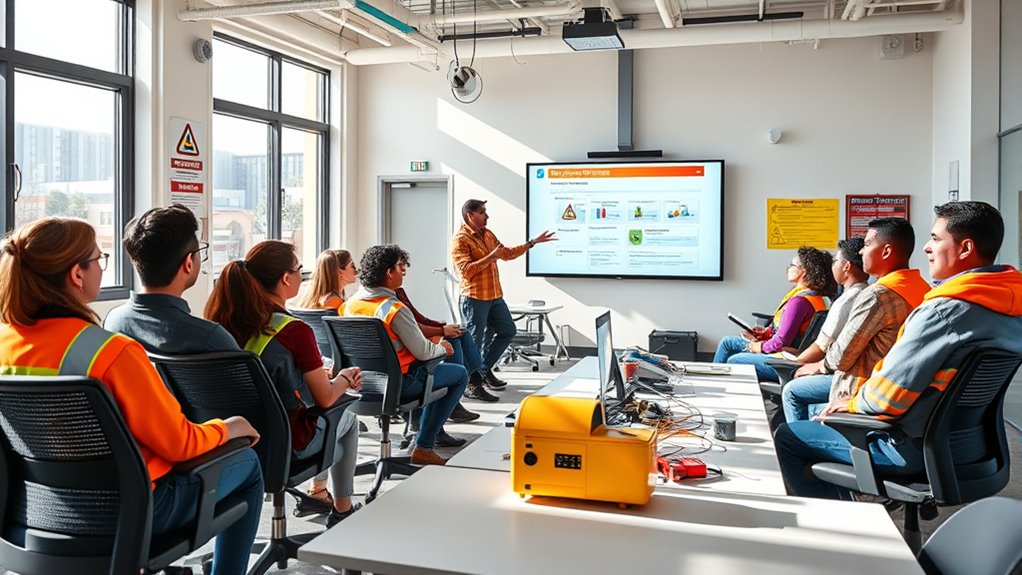To create a safety-focused culture, assess your team’s needs by reviewing incident reports and gathering feedback. Develop engaging, role-specific content that includes real-life scenarios and interactive activities. Use hands-on, scenario-based training and incorporate technology like virtual reality or apps to boost engagement. Promote open communication through feedback channels and regular safety talks. Continuously evaluate and improve your training processes—if you keep investing in these tactics, you’ll build a truly safer environment.
Key Takeaways
- Conduct needs assessments and measure training effectiveness through incident data, surveys, and safety performance metrics.
- Develop engaging, role-specific content using real-life scenarios, interactive tools, and ongoing refresher courses.
- Implement hands-on, scenario-based, and technology-enhanced training like simulations, virtual reality, and data analytics.
- Foster open communication and trust with feedback channels, safety discussions, and a non-punitive environment.
- Promote decision-making skills through real incident analysis, diverse scenario practice, and continuous learning initiatives.
Assessing Training Needs to Align Safety Goals
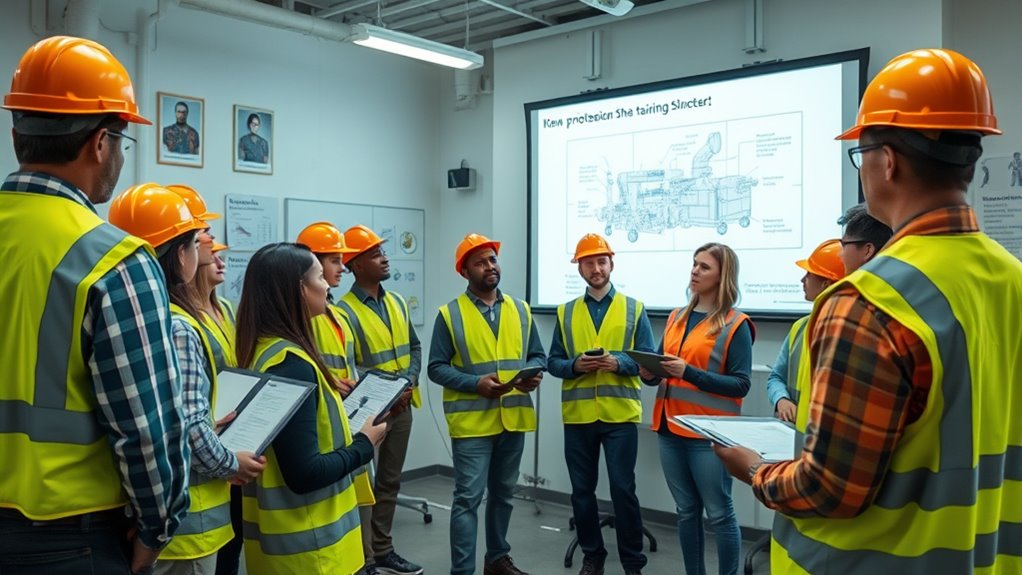
To effectively create a culture of safety, you first need to identify where your team’s training falls short of safety objectives. Begin by reviewing incident reports, near-misses, and safety audits to spot recurring issues. Talk directly with staff to understand their concerns and gaps in knowledge or skills. Conduct surveys or assessments to gauge current competency levels related to safety protocols. Comparing these findings against your safety goals helps reveal specific areas needing improvement. Prioritize training topics that address high-risk tasks and common errors. This targeted approach ensures your training efforts are relevant and impactful. Regularly reassess these needs to adapt to changes in operations, technology, or regulations, keeping safety front and center in your team’s development. Additionally, understanding vetted – Mother Baby Kids standards can help tailor training to ensure safety practices are aligned with current child and maternal safety guidelines.
Developing Engaging and Relevant Training Content
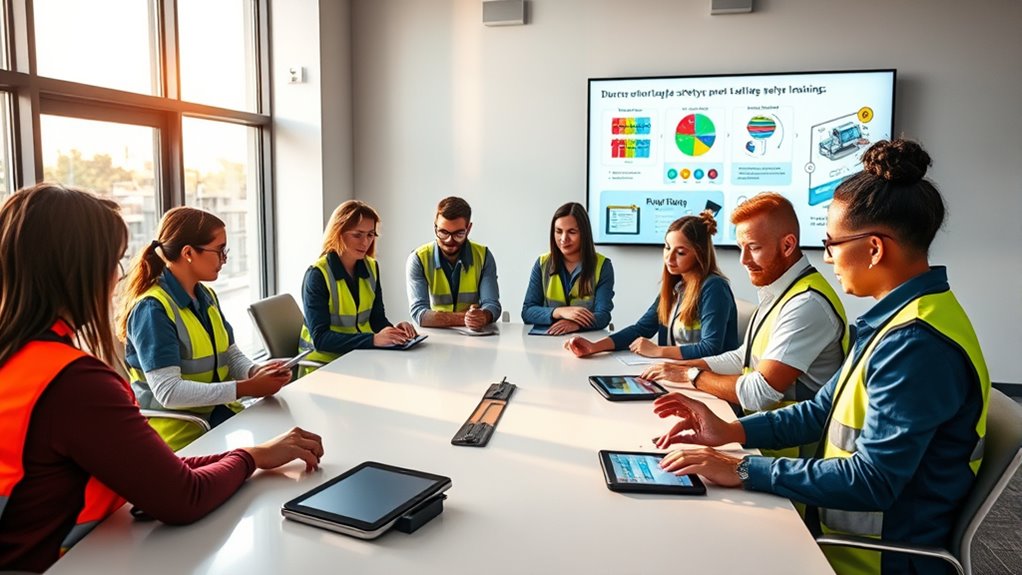
To keep safety training effective, you need to tailor content to specific roles so everyone sees its relevance. Incorporating real-life scenarios makes lessons more relatable and memorable, while interactive formats boost engagement. When you combine these elements, your training becomes a powerful tool for fostering a safety-focused culture. Paying attention to essential oils for health can also enhance overall well-being in the workplace.
Align Content With Roles
How can you guarantee that safety training resonates with your team? The key is aligning your content with each role’s specific responsibilities. Start by understanding what safety risks each position faces and tailor your training to address those challenges directly. Use language and examples relevant to their daily tasks, making the material feel personal and applicable. Incorporate role-specific procedures, tools, and protocols so employees see how safety measures fit into their routines. Avoid generic content; instead, focus on practical scenarios relevant to their work. When training connects directly to their roles, employees are more engaged, retain information better, and feel empowered to act safely. This targeted approach fosters a safety culture rooted in relevance and clarity, similar to the way inspirational quotes can motivate personal growth and a positive mindset.
Incorporate Real-Life Scenarios
What makes safety training truly stick is its relevance to real-life situations employees face daily. Incorporating real-life scenarios helps staff see the immediate importance of safety protocols. Use actual incidents or realistic simulations that mirror everyday challenges. This approach boosts engagement and retention, making safety procedures feel less abstract. To illustrate this, consider the following examples:
| Situation | Response Strategy |
|---|---|
| Slip on wet floor | Use proper signage and quick cleanup |
| Incorrect lifting | Demonstrate correct techniques |
| Fire alarm activation | Follow evacuation procedures |
| Handling hazardous materials | Wear appropriate PPE |
| Distraction while working | Emphasize focus and alertness |
These scenarios help staff internalize safety habits by connecting training to their work environment. Effective training methods further reinforce these lessons and ensure safety practices become second nature.
Use Interactive Formats
Interactive formats transform safety training from a passive lecture into an engaging experience that resonates with employees. By actively involving staff, you boost retention and foster a safety-first mindset. Consider incorporating these techniques:
- Simulations and role-playing to replicate real workplace challenges.
- Quizzes and gamified activities to reinforce key concepts and maintain engagement.
- Group discussions and problem-solving exercises that encourage collaboration.
- Hands-on demonstrations allowing employees to practice safety procedures firsthand.
- Integrate effective design principles to ensure your training materials are accessible and impactful.
These methods make learning more relevant and memorable, helping your team internalize safety protocols. When employees participate actively, they’re more likely to apply what they learn and develop confidence in handling safety issues. Using interactive formats keeps training dynamic, impactful, and aligned with your safety culture goals.
Incorporating Hands-On and Scenario-Based Learning
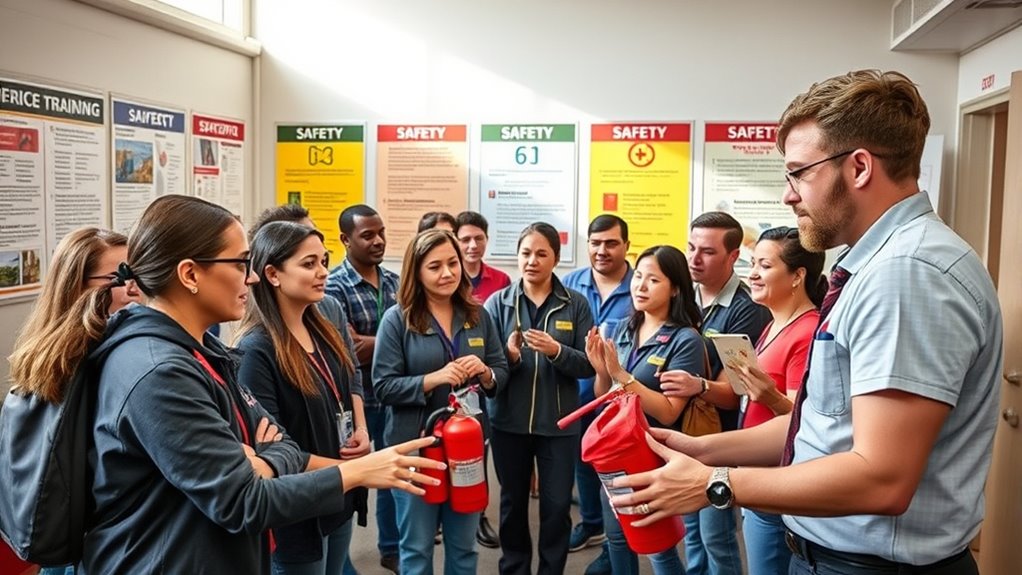
Incorporating hands-on and scenario-based learning helps you prepare staff for real-world challenges. Using realistic practice scenarios and interactive simulations sharpens decision-making skills and builds confidence. This approach guarantees safety protocols become second nature in high-pressure situations, much like the diverse designs available in unique and wicked planters that foster creativity and adaptability.
Realistic Practice Scenarios
To build a strong safety culture, you need realistic practice scenarios that closely mirror actual work situations. These scenarios help staff develop critical thinking and quick decision-making skills essential during emergencies. When designing these exercises, focus on authenticity and relevance, so team members can connect practice to real-life challenges. Consider these key elements:
- Incorporate common hazards your team faces regularly
- Simulate time-sensitive situations to enhance responsiveness
- Use genuine equipment and environment setups for immersion
- Debrief thoroughly to identify strengths and areas for improvement
- Integrate AI security principles to anticipate and respond to emerging threats effectively.
Interactive Simulation Techniques
Hands-on and scenario-based learning techniques bring safety training to life by engaging you directly in realistic situations. These methods allow you to practice responses in a safe environment, helping you develop confidence and competence. You might participate in simulated emergency drills or role-playing exercises that mimic real-world challenges. This active involvement helps solidify your understanding of safety protocols and encourages quick, effective decision-making. Interactive simulations also foster teamwork, as you collaborate with colleagues to solve problems and manage crises. By experiencing high-pressure scenarios firsthand, you build muscle memory and reduce hesitation during actual emergencies. These techniques make safety training more dynamic, memorable, and impactful, ensuring you’re better prepared to handle unexpected events and contribute to a culture of safety within your organization. Waterproof running watches and other high-tech gear can also enhance safety by providing real-time data during training and emergencies.
Enhancing Decision-Making Skills
By actively engaging in scenario-based learning, you can substantially enhance your decision-making skills in safety situations. This approach immerses you in realistic contexts, helping you develop quick, effective responses. To maximize this, consider:
- Analyzing real-world incidents to identify key decision points
- Practicing with diverse scenarios to build adaptability
- Reflecting on outcomes to improve future choices
- Receiving feedback from experienced trainers to refine your judgment
- Incorporating continuous learning to stay updated on best practices and emerging risks
These tactics sharpen your ability to assess risks rapidly, prioritize actions, and make informed decisions under pressure. Consistent practice with varied scenarios builds confidence and hones your instincts, ultimately fostering a safety-conscious culture. Incorporating hands-on, scenario-based learning empowers you to handle critical moments with clarity and precision.
Promoting Continuous Learning and Skill Reinforcement
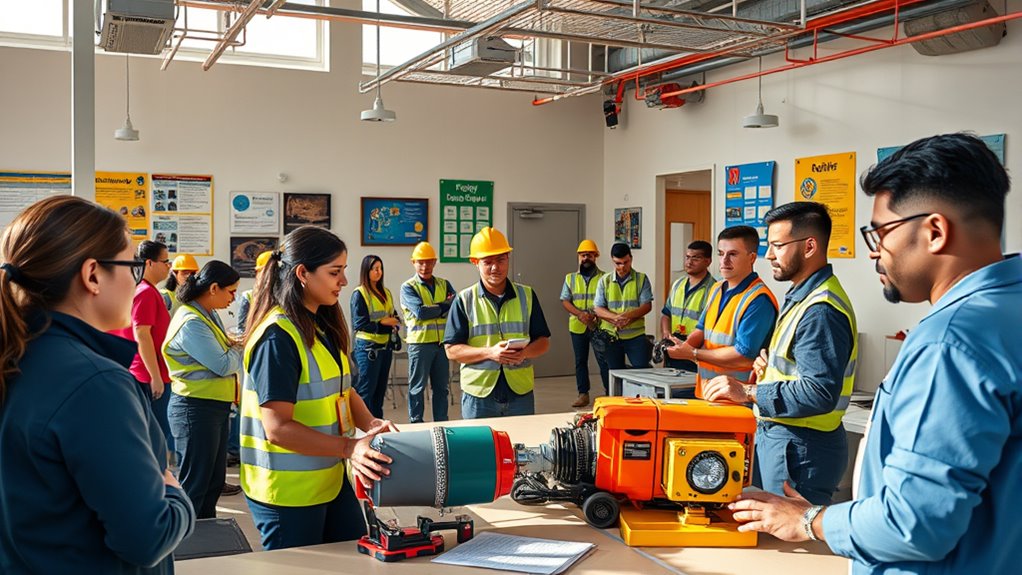
Continuous learning and skill reinforcement are essential for maintaining a strong safety culture, as they guarantee employees stay knowledgeable and prepared for evolving workplace risks. You should encourage ongoing education through refresher courses, workshops, and real-world practice sessions. Regularly evaluating skills helps identify areas that need improvement, ensuring everyone remains confident in their safety procedures. Reinforce safe behaviors by providing feedback and recognizing safety milestones. Make learning a continuous process by integrating safety discussions into daily routines and team meetings. When employees see continuous growth as a priority, they’re more likely to stay engaged and proactive about safety. Incorporating up-to-date safety information ensures that training remains relevant and effective. This ongoing commitment helps prevent accidents, fosters accountability, and creates an environment where safety becomes second nature.
Utilizing Technology to Enhance Safety Training

Harnessing the power of technology can considerably boost safety training efforts. By integrating advanced tools, you can create more engaging and effective programs. Consider these strategies:
- Use virtual reality simulations to replicate real-life scenarios, helping staff practice responses without risk.
- Implement e-learning platforms that allow flexible, self-paced training, ensuring consistent knowledge across teams.
- Incorporate mobile apps for quick access to safety protocols and instant updates on procedures.
- Utilize data analytics to track progress, identify gaps, and tailor training modules for targeted improvement.
These technological solutions streamline the training process, increase retention, and foster a proactive safety culture. Embracing technology empowers your team to stay prepared and confident in maintaining a safe work environment.
Fostering Open Communication and Feedback Channels

Open and honest communication forms the backbone of a strong safety culture. You should encourage staff to speak up about concerns without fear of blame or reprisal. Create clear channels, like anonymous reporting systems or regular safety meetings, where team members can share feedback openly. Make it easy for everyone to voice their observations and suggestions, demonstrating that their input is valued. Actively listen to concerns and respond promptly, showing that feedback leads to real change. Foster a non-punitive environment where mistakes are seen as opportunities to learn rather than blame. When communication flows freely, issues are identified early, and safety improves. Building trust and transparency ensures your team feels empowered and committed to maintaining a safe workplace.
Measuring Training Effectiveness and Making Improvements

To guarantee your safety training is effective, you need to regularly measure its impact and identify areas for improvement. Start by collecting feedback through surveys or interviews to understand participants’ perspectives. Next, evaluate knowledge retention with quizzes or practical assessments. Third, monitor real-world safety performance metrics to see if training translates into fewer incidents. Finally, analyze trends over time to identify persistent gaps or new risks. You should then use this data to refine your training programs, focusing on areas needing enhancement. Continually adjusting your approach ensures training remains relevant and impactful. Regular measurement and adaptation help foster a culture of safety, making sure your team is well-prepared and engaged in maintaining a safe work environment.
Frequently Asked Questions
How Can Leadership Effectively Model Safety Behaviors?
You can effectively model safety behaviors by consistently demonstrating best practices and prioritizing safety in all actions. Lead by example, communicate openly about safety concerns, and follow safety protocols without exception. When you visibly value safety, staff will mirror your behavior, fostering a culture where safety becomes a shared responsibility. Your commitment encourages others to adopt safe practices, making safety an integral part of your organization’s daily operations.
What Are Common Barriers to Staff Participation in Safety Training?
Think of safety training as planting seeds—you might hit rocky soil if staff face barriers. Common obstacles include time constraints, feeling overwhelmed, or perceiving training as unnecessary. You might also encounter resistance due to past experiences or a lack of perceived relevance. To break these barriers, you need to cultivate engagement, make training accessible, and show staff how safety directly benefits them, turning resistance into growth.
How Do Cultural Differences Impact Safety Training Approaches?
Cultural differences considerably impact your safety training approaches. You might find that language barriers, varying beliefs about authority, and different attitudes towards risk influence how staff engage with training. To guarantee effectiveness, you should customize your methods to respect diverse backgrounds, incorporate multilingual resources, and promote open dialogue. By understanding these cultural nuances, you can create a more inclusive environment where everyone feels valued and motivated to participate actively in safety initiatives.
What Role Does Employee Recognition Play in Safety Culture?
You might not realize it, but recognizing employees plays a crucial role in fostering a safety-focused environment. When you acknowledge safe behaviors, you encourage others to follow suit, building trust and motivation. Celebrating safety milestones or efforts makes staff feel valued and committed to safety practices. This positive reinforcement helps embed safety into your workplace culture, ensuring everyone stays vigilant and proactive, ultimately reducing risks and promoting a safer work environment.
How Can Training Be Adapted for Remote or Hybrid Teams?
You can adapt training for remote or hybrid teams by leveraging digital tools like video conferencing, online modules, and interactive simulations. Keep sessions engaging and accessible, encouraging participation through polls and Q&A. Schedule regular check-ins to reinforce safety practices, and provide on-demand resources for ongoing learning. This approach guarantees your team stays informed, connected, and committed to safety, no matter where they work.
Conclusion
Think of creating a safety culture as tending a garden—you plant the seeds with effective training, nurture growth through ongoing learning, and watch safety flourish. By evaluating needs, engaging staff, embracing technology, and encouraging open dialogue, you cultivate a resilient environment where safety blossoms. Keep measuring and refining your efforts, and you’ll see your team’s confidence and vigilance grow stronger each day, transforming your workplace into a thriving, secure haven where everyone can flourish.
